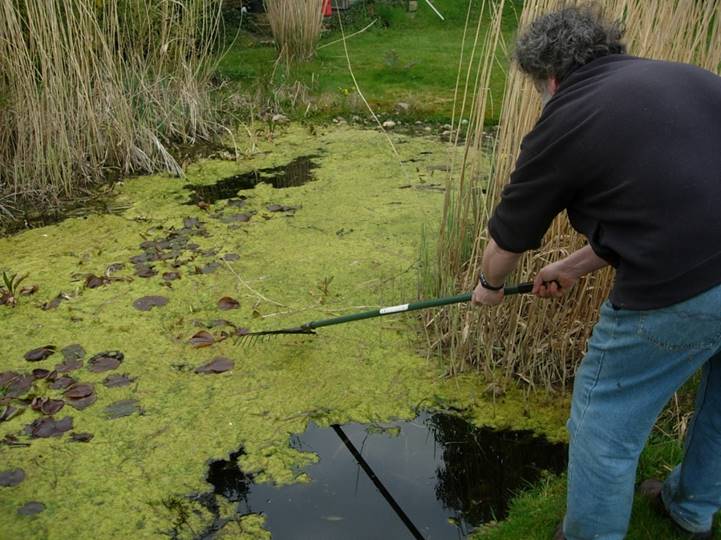- Home
- Wild plants
- Algae
Garden Algae - introduction
Algae are simple plants, but they account for a major proportion of the oxygen production of the planet. The term "algae" isn't scientifically valid, but is a gather-all name for a very varied set of photosynthetic bacteria and plants. They vary from tiny single-celled planktonic species, through pond blanket weed, up to the remarkable seaweeds and kelps, that can grow to 80m in length.
Algae aren't often covered in books on garden wildlife, but they are very significant in garden ponds and streams, as tiny plankton and larger, often problematic filamentous forms. They are covered in our page on pond algae. Algae are also abundant in soils and on many surfaces on land, and we cover those in a separate page.
Basic types of "algae"
There are two different types of living cells. Those of plants, fungi and animals are complex structures, in which the genetic information is held as DNA within a nucleus inside a nuclear membrane. They also have special internal membrane-bound "organelles" such as energy-releasing mitochondria and light collecting chloroplasts. These organisms are termed eucaryotes, in contrast with the simpler-celled procaryotes which lack internal membrane-bound structures. American authors use the spellings eukaryote and prokaryote. Procaryotes include the immensely diverse bacteria and the curious archaea, which appear more closely related to the eucaryotes. Procaryote cells are very small and usually isolated, although some will form into strings or sticky masses.
To complicate matters, there is good evidence that the mitochondria and chloroplasts in eucaryote cells are essentially symbiotic bacteria which became permanently incorporated within an ancestral archaean cell giving rise to eucaryotic cells. Mitochondria were incorporated about 2.2 billion years ago into the ancestral eucaryotes, while chloroplasts joined into the lineage leading to photosynthetic algae and plants about 600 million years later.
Very simplified diagrams to show differences between basic cell types.
Procaryotic algae
A large number of bacteria are photosynthetic and were once called "blue-green algae", but this masked the fact they are radically unrelated to the eucaryotic forms. They are now called Cyanobacteria .
These tiny photosynthetic bacteria are of huge ecological and geological significance as the first organisms to produce oxygen some 2.5 billion years ago, and all other photosynthetic organisms appear to be derived from them. About 1.5 to 1.2 billion years ago a group of cyanobacteria became symbiotic within the cells of algae and subsequently higher plants as structures called chloroplasts which are the essential photosynthesizing components within all plants. Cyanobacteria are abundant in garden ponds and in soils and are covered in the relevant pages on this site.
Freshwater algae: Spirogyra Removing blanket weed Colony of Volvox
Algae are also present in the terrestrial environment, often as a film of green on damp soil, tree trunks, pots and garden decking, but sometimes as strange gelatinous masses that appear in the autumn. We will be covering these with another page.
Page written and compiled by Steve Head
_2014-09-20_20x_IMG_5384.jpg)


Algae
Algae are simple plants, but they account for a major proportion of the oxygen production of the planet. The term isn't scientifically valid, but is a gather-all name for a very varied set of photosynthetic plants. They vary from tiny single-celled planktonic groups, through pond blanket weed, up to the remarkable seaweeds and kelps, that can grow to 80m in length.
Algae aren't often covered in books on garden wildlife, but they are very significant in garden ponds and streams, as tiny plankton and larger, often problematic filamentous forms. We will soon be creating a page on pond algae

Eucaryotic algae
There are very many different types of eucaryotic algae, which are vastly more different one from another than are the groups of land plants. Many are spoken of as "green", "red", "brown" or "golden" algae, but there are many more groups. Details of classification are really only of interest to specialists, and will not be detailed in the accounts of pond and land algae. Within one such group, the Charophyta we can place the origin of the multicellular land plants.

Nostoc, a terrestrial cyanobacterium froming the rather revolting green mass on the soil surface between the plants.

When ponds go bad.......
Removing blanket weed - filamentous eucaryotic algae - from my garden pond
Page written and compiled by Steve Head






